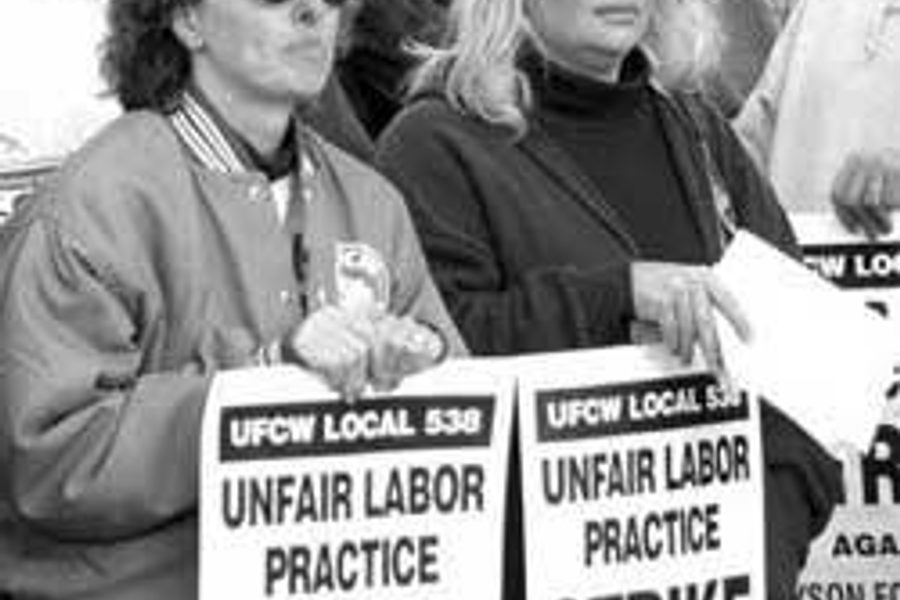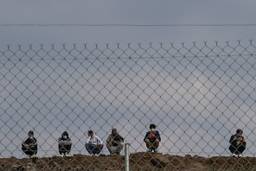
Visitors passing through Wisconsin on their way to Madison or Milwaukee might happen into a dense forest of billboards and yard signs called Jefferson. This farmland town of less than 8,000 is up in arms, fighting off a corporate assault that threatens its existence. And it’s not just one town. The corporate giant in this story has taken aim at workers in an entire industry—and by extension hundreds of communities nationwide.
Ground zero is Jefferson’s pork processing plant, which produces 65 million pounds of pepperoni a year, more than half the pepperoni used on Pizza Hut and Kraft pizzas. Like other workers in the heavily unionized beef and pork processing industry, and unlike poultry processing workers, generations of employees at the Jefferson plant have enjoyed relatively good wages and benefits—and never had to strike in the plant’s 124-year history, until now.
“Tyson is trying to make more money by taking away our wages, taking away affordable health care and taking us away from our children,” says Lisa Dehnert, an employee at the Jefferson plant for 16 years and a single mom.
At issue in Jefferson is starting pay, vacation time, health and other benefits, all of which new plant owner Tyson Foods proposes to cut, as well as chopping off the pension in favor of a 401(k) plan heavily invested in Tyson stock, Enron-style.
But workers at dozens of beef and pork processing plants across the country see Jefferson’s fight as just the beginning. “We can have the fight now in Jefferson,” says one Oscar Mayer employee in Madison, “or down the road at our plant later.”
Tyson Foods, by far the largest poultry processor in the world, moved into beef and pork in 2001 with its purchase of IBP Fresh Meats, formerly Iowa Beef Processing. A federal lawsuit had prevented the nation’s biggest pork processor, Smithfield Foods, from buying IBP because of antitrust concerns. Tyson had reached its own limit in poultry and quickly swooped down on IBP, including the Jefferson plant. Jefferson workers say they saw the writing on the wall right away.
“It was the saddest day of my life,” says union president Mike Rice.
The strikers are members of United Food and Commercial Workers, the same union that has fought Tyson elsewhere. They are well aware of Tyson’s record of hoarding profits—more than $2.23 billion last year alone—while workers endure low pay and rising safety violations. In 1999, seven Tyson employees were killed at work, including two who fell into an open pit of decomposing chicken parts and suffocated. The same year in Corydon, Indiana, Tyson employees went on strike after several workers were disciplined for discarding diseased meat.
So when Tyson informed union negotiators in Jefferson last fall that the company planned to bring them into line with their other operations, workers knew they had to fight.
They walked out in February 2003, when their last contract extension expired, calling a national boycott of Tyson-made pepperoni. The community responded immediately. Passersby stopped at the picket line to hand out coffee and donuts. A local pharmacist donated free milk to children of strikers. Local supermarkets pulled Tyson products off the shelves. Nearby city councils and school boards voted to stop buying Tyson products in their cafeterias and lunchrooms.
Nine months later, community support has heightened, and donations are pouring in from all over the United States. Only five of the 470 union members have crossed the picket line. Even a recent funeral in Jefferson became a kind of proxy picket line when the siblings of the deceased, an ardent union activist named Mike Barkley, stood up and announced that they were donating what they would have spent on their brother at Christmas to the local strike fund.
“People make movies and write books about stuff like this,” says union spokesman Dick Knapp.
But what makes a community mobilize like this on behalf of a small group of workers? What makes strangers around the country dig deep to help a little town in Wisconsin? And why would a group of workers endure the hardship—living hand to mouth on donated canned goods, many now without health insurance—over changes that, as the company points out, “primarily affect new hires”?
Partly, the strikers say, it’s because a family of four cannot live on $9 an hour without becoming “a burden on the state.” Partly, they say, it’s because increasing numbers of workers face a similar threat. But mostly, Knapp says, “It’s about community.”
For more information, please see www.tysonfamiliesstandup.org.
Ground zero is Jefferson’s pork processing plant, which produces 65 million pounds of pepperoni a year, more than half the pepperoni used on Pizza Hut and Kraft pizzas. Like other workers in the heavily unionized beef and pork processing industry, and unlike poultry processing workers, generations of employees at the Jefferson plant have enjoyed relatively good wages and benefits—and never had to strike in the plant’s 124-year history, until now.
“Tyson is trying to make more money by taking away our wages, taking away affordable health care and taking us away from our children,” says Lisa Dehnert, an employee at the Jefferson plant for 16 years and a single mom.
At issue in Jefferson is starting pay, vacation time, health and other benefits, all of which new plant owner Tyson Foods proposes to cut, as well as chopping off the pension in favor of a 401(k) plan heavily invested in Tyson stock, Enron-style.
But workers at dozens of beef and pork processing plants across the country see Jefferson’s fight as just the beginning. “We can have the fight now in Jefferson,” says one Oscar Mayer employee in Madison, “or down the road at our plant later.”
Tyson Foods, by far the largest poultry processor in the world, moved into beef and pork in 2001 with its purchase of IBP Fresh Meats, formerly Iowa Beef Processing. A federal lawsuit had prevented the nation’s biggest pork processor, Smithfield Foods, from buying IBP because of antitrust concerns. Tyson had reached its own limit in poultry and quickly swooped down on IBP, including the Jefferson plant. Jefferson workers say they saw the writing on the wall right away.
“It was the saddest day of my life,” says union president Mike Rice.
The strikers are members of United Food and Commercial Workers, the same union that has fought Tyson elsewhere. They are well aware of Tyson’s record of hoarding profits—more than $2.23 billion last year alone—while workers endure low pay and rising safety violations. In 1999, seven Tyson employees were killed at work, including two who fell into an open pit of decomposing chicken parts and suffocated. The same year in Corydon, Indiana, Tyson employees went on strike after several workers were disciplined for discarding diseased meat.
So when Tyson informed union negotiators in Jefferson last fall that the company planned to bring them into line with their other operations, workers knew they had to fight.
They walked out in February 2003, when their last contract extension expired, calling a national boycott of Tyson-made pepperoni. The community responded immediately. Passersby stopped at the picket line to hand out coffee and donuts. A local pharmacist donated free milk to children of strikers. Local supermarkets pulled Tyson products off the shelves. Nearby city councils and school boards voted to stop buying Tyson products in their cafeterias and lunchrooms.
Nine months later, community support has heightened, and donations are pouring in from all over the United States. Only five of the 470 union members have crossed the picket line. Even a recent funeral in Jefferson became a kind of proxy picket line when the siblings of the deceased, an ardent union activist named Mike Barkley, stood up and announced that they were donating what they would have spent on their brother at Christmas to the local strike fund.
“People make movies and write books about stuff like this,” says union spokesman Dick Knapp.
But what makes a community mobilize like this on behalf of a small group of workers? What makes strangers around the country dig deep to help a little town in Wisconsin? And why would a group of workers endure the hardship—living hand to mouth on donated canned goods, many now without health insurance—over changes that, as the company points out, “primarily affect new hires”?
Partly, the strikers say, it’s because a family of four cannot live on $9 an hour without becoming “a burden on the state.” Partly, they say, it’s because increasing numbers of workers face a similar threat. But mostly, Knapp says, “It’s about community.”
For more information, please see www.tysonfamiliesstandup.org.
Ricky Baldwin is a longtime labor activist and writer whose articles have appeared in such publications as Dollars & Sense, Extra! and Z Magazine.





